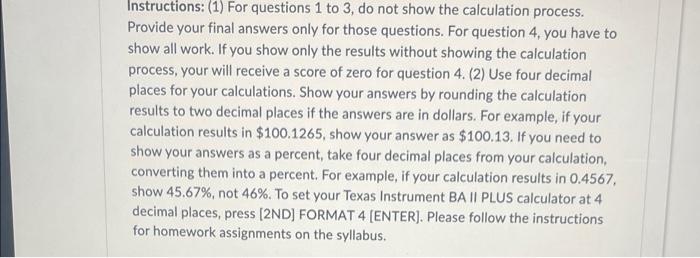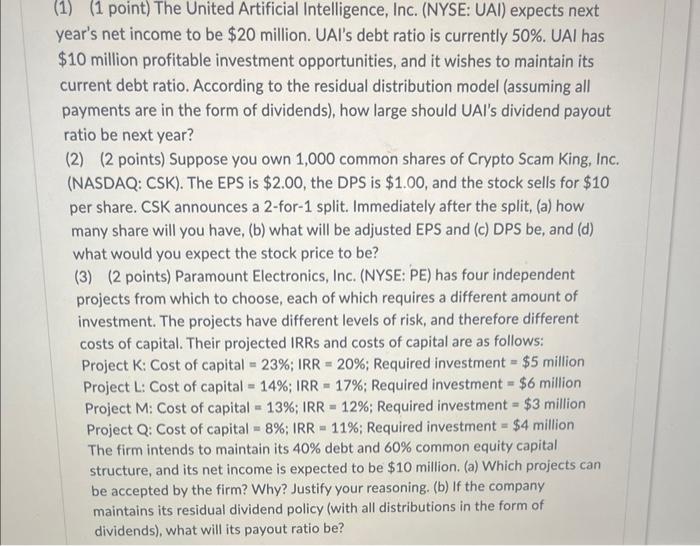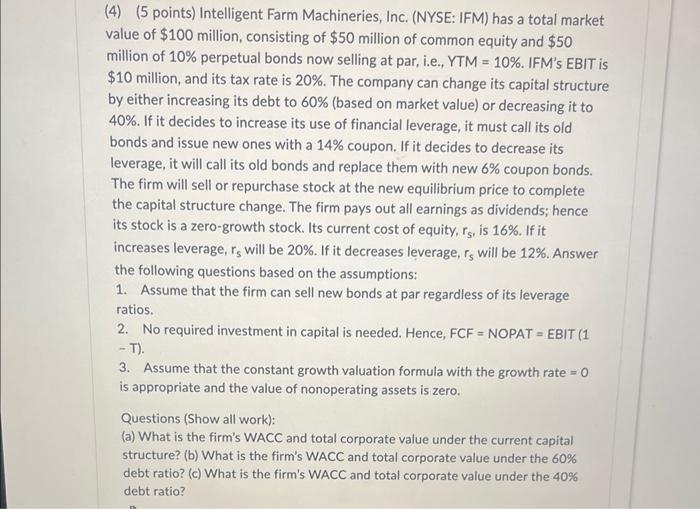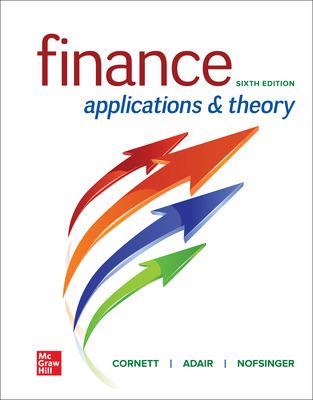Instructions: (1) For questions 1 to 3 , do not show the calculation process. Provide your final answers only for those questions. For question 4, you have to show all work. If you show only the results without showing the calculation process, your will receive a score of zero for question 4. (2) Use four decimal places for your calculations. Show your answers by rounding the calculation results to two decimal places if the answers are in dollars. For example, if your calculation results in $100.1265, show your answer as $100.13. If you need to show your answers as a percent, take four decimal places from your calculation, converting them into a percent. For example, if your calculation results in 0.4567, show 45.67%, not 46%. To set your Texas Instrument BA II PLUS calculator at 4 decimal places, press [2ND] FORMAT 4 [ENTER]. Please follow the instructions for homework assignments on the syllabus. year's net income to be $20 million. UAl's debt ratio is currently 50%. UAI has $10 million profitable investment opportunities, and it wishes to maintain its current debt ratio. According to the residual distribution model (assuming all payments are in the form of dividends), how large should UAl's dividend payout ratio be next year? (2) (2 points) Suppose you own 1,000 common shares of Crypto Scam King, Inc. (NASDAQ: CSK). The EPS is $2.00, the DPS is $1.00, and the stock sells for $10 per share. CSK announces a 2 -for-1 split. Immediately after the split, (a) how many share will you have, (b) what will be adjusted EPS and (c) DPS be, and (d) what would you expect the stock price to be? (3) (2 points) Paramount Electronics, Inc. (NYSE: PE) has four independent projects from which to choose, each of which requires a different amount of investment. The projects have different levels of risk, and therefore different costs of capital. Their projected IRRs and costs of capital are as follows: Project K: Cost of capital =23%; IRR =20%; Required investment =$5 million Project L: Cost of capital =14%;IRR=17%; Required investment =$6 million Project M: Cost of capital =13%;IRR=12%; Required investment =$3 million Project Q: Cost of capital =8%; IRR=11%; Required investment =$4 million The firm intends to maintain its 40% debt and 60% common equity capital structure, and its net income is expected to be $10 million. (a) Which projects can be accepted by the firm? Why? Justify your reasoning. (b) If the company maintains its residual dividend policy (with all distributions in the form of dividends), what will its payout ratio be? (4) (5 points) Intelligent Farm Machineries, Inc. (NYSE: IFM) has a total market value of $100 million, consisting of $50 million of common equity and $50 million of 10% perpetual bonds now selling at par, i.e., YTM=10%. IFM's EBIT is $10 million, and its tax rate is 20%. The company can change its capital structure by either increasing its debt to 60% (based on market value) or decreasing it to 40%. If it decides to increase its use of financial leverage, it must call its old bonds and issue new ones with a 14% coupon. If it decides to decrease its leverage, it will call its old bonds and replace them with new 6% coupon bonds. The firm will sell or repurchase stock at the new equilibrium price to complete the capital structure change. The firm pays out all earnings as dividends; hence its stock is a zero-growth stock. Its current cost of equity, r5, is 16%. If it increases leverage, rs will be 20%. If it decreases leverage, r5 will be 12%. Answer the following questions based on the assumptions: 1. Assume that the firm can sell new bonds at par regardless of its leverage ratios. 2. No required investment in capital is needed. Hence, FCF= NOPAT = EBIT (1 - T). 3. Assume that the constant growth valuation formula with the growth rate =0 is appropriate and the value of nonoperating assets is zero. Questions (Show all work): (a) What is the firm's WACC and total corporate value under the current capital structure? (b) What is the firm's WACC and total corporate value under the 60% debt ratio? (c) What is the firm's WACC and total corporate value under the 40% debt ratio? Instructions: (1) For questions 1 to 3 , do not show the calculation process. Provide your final answers only for those questions. For question 4, you have to show all work. If you show only the results without showing the calculation process, your will receive a score of zero for question 4. (2) Use four decimal places for your calculations. Show your answers by rounding the calculation results to two decimal places if the answers are in dollars. For example, if your calculation results in $100.1265, show your answer as $100.13. If you need to show your answers as a percent, take four decimal places from your calculation, converting them into a percent. For example, if your calculation results in 0.4567, show 45.67%, not 46%. To set your Texas Instrument BA II PLUS calculator at 4 decimal places, press [2ND] FORMAT 4 [ENTER]. Please follow the instructions for homework assignments on the syllabus. year's net income to be $20 million. UAl's debt ratio is currently 50%. UAI has $10 million profitable investment opportunities, and it wishes to maintain its current debt ratio. According to the residual distribution model (assuming all payments are in the form of dividends), how large should UAl's dividend payout ratio be next year? (2) (2 points) Suppose you own 1,000 common shares of Crypto Scam King, Inc. (NASDAQ: CSK). The EPS is $2.00, the DPS is $1.00, and the stock sells for $10 per share. CSK announces a 2 -for-1 split. Immediately after the split, (a) how many share will you have, (b) what will be adjusted EPS and (c) DPS be, and (d) what would you expect the stock price to be? (3) (2 points) Paramount Electronics, Inc. (NYSE: PE) has four independent projects from which to choose, each of which requires a different amount of investment. The projects have different levels of risk, and therefore different costs of capital. Their projected IRRs and costs of capital are as follows: Project K: Cost of capital =23%; IRR =20%; Required investment =$5 million Project L: Cost of capital =14%;IRR=17%; Required investment =$6 million Project M: Cost of capital =13%;IRR=12%; Required investment =$3 million Project Q: Cost of capital =8%; IRR=11%; Required investment =$4 million The firm intends to maintain its 40% debt and 60% common equity capital structure, and its net income is expected to be $10 million. (a) Which projects can be accepted by the firm? Why? Justify your reasoning. (b) If the company maintains its residual dividend policy (with all distributions in the form of dividends), what will its payout ratio be? (4) (5 points) Intelligent Farm Machineries, Inc. (NYSE: IFM) has a total market value of $100 million, consisting of $50 million of common equity and $50 million of 10% perpetual bonds now selling at par, i.e., YTM=10%. IFM's EBIT is $10 million, and its tax rate is 20%. The company can change its capital structure by either increasing its debt to 60% (based on market value) or decreasing it to 40%. If it decides to increase its use of financial leverage, it must call its old bonds and issue new ones with a 14% coupon. If it decides to decrease its leverage, it will call its old bonds and replace them with new 6% coupon bonds. The firm will sell or repurchase stock at the new equilibrium price to complete the capital structure change. The firm pays out all earnings as dividends; hence its stock is a zero-growth stock. Its current cost of equity, r5, is 16%. If it increases leverage, rs will be 20%. If it decreases leverage, r5 will be 12%. Answer the following questions based on the assumptions: 1. Assume that the firm can sell new bonds at par regardless of its leverage ratios. 2. No required investment in capital is needed. Hence, FCF= NOPAT = EBIT (1 - T). 3. Assume that the constant growth valuation formula with the growth rate =0 is appropriate and the value of nonoperating assets is zero. Questions (Show all work): (a) What is the firm's WACC and total corporate value under the current capital structure? (b) What is the firm's WACC and total corporate value under the 60% debt ratio? (c) What is the firm's WACC and total corporate value under the 40% debt ratio









